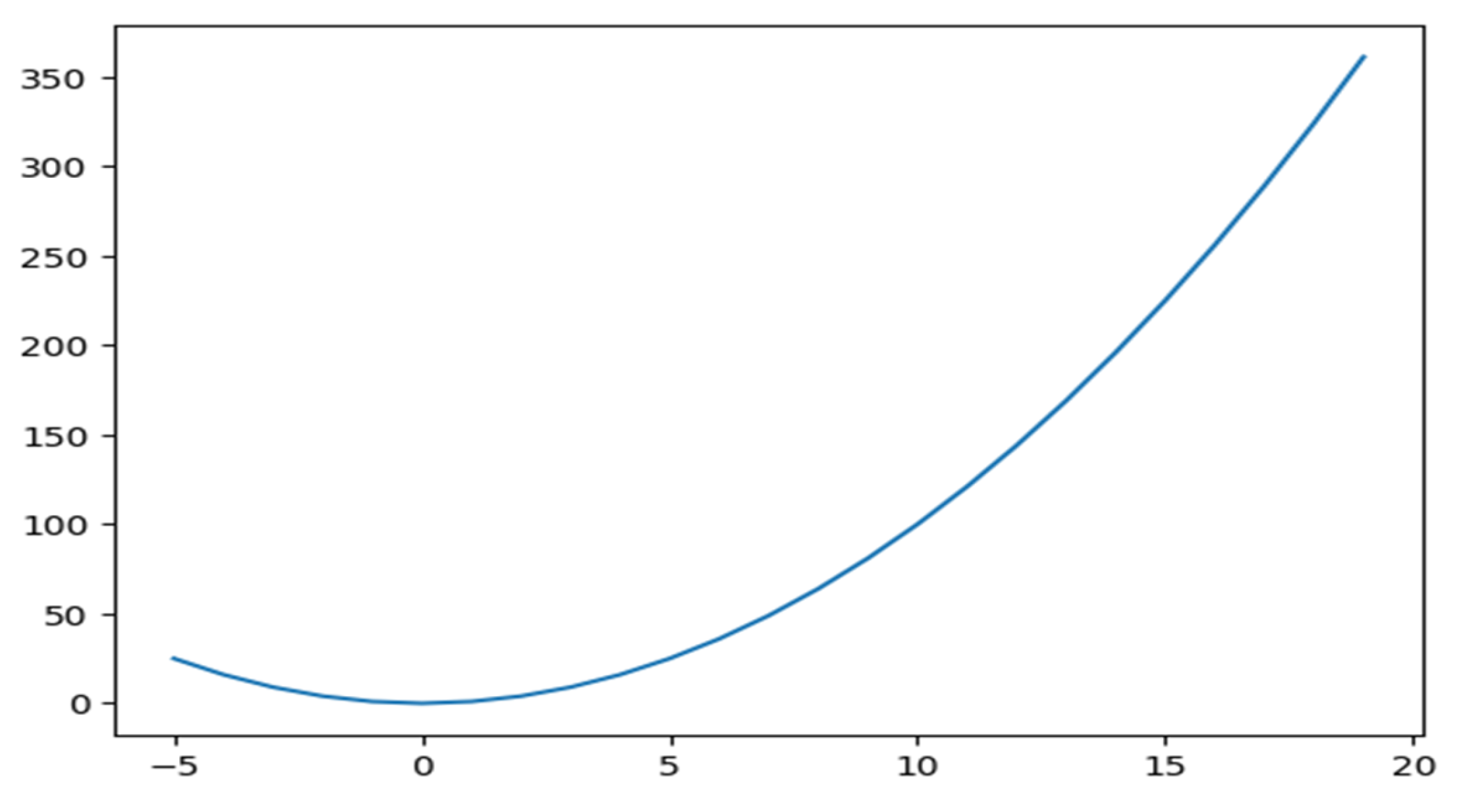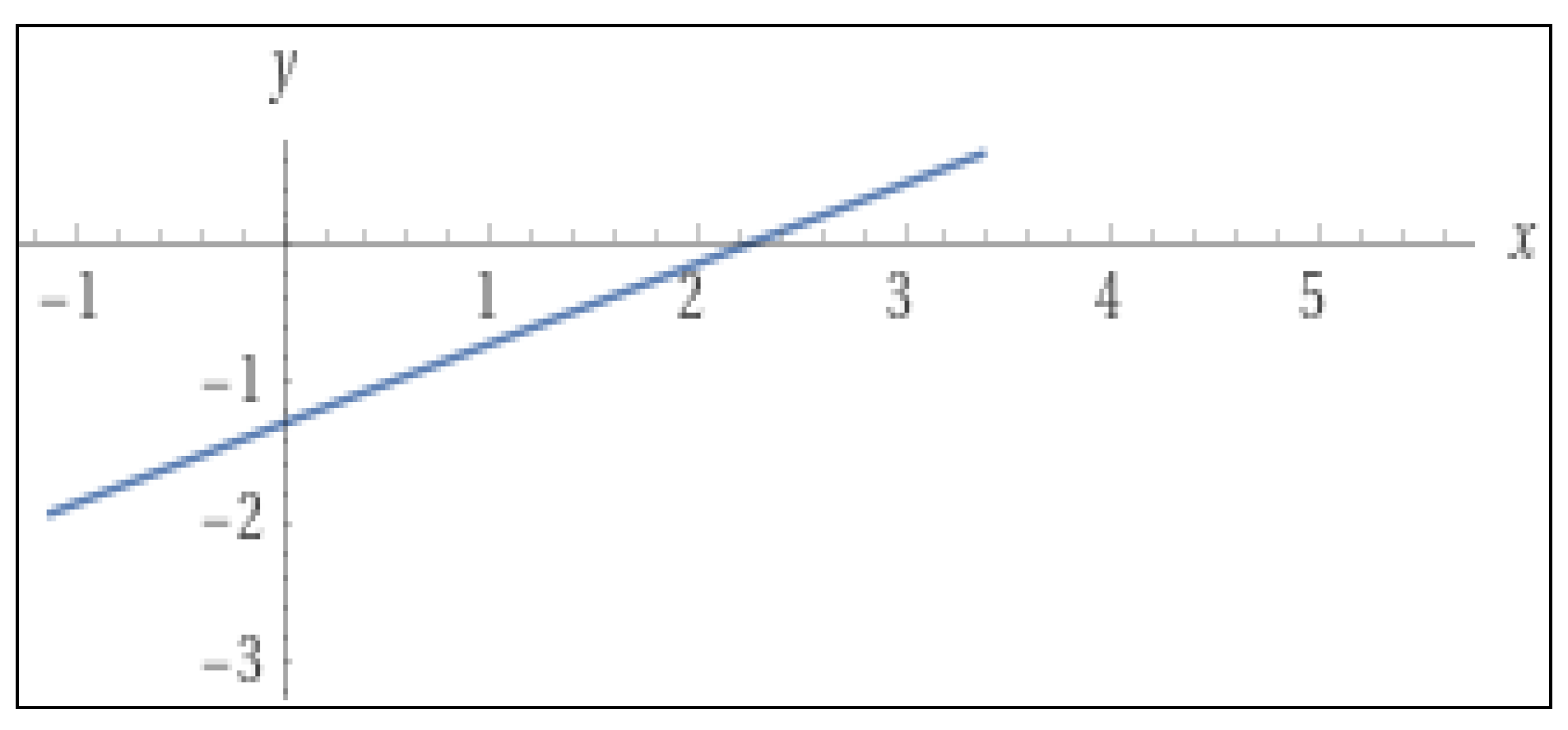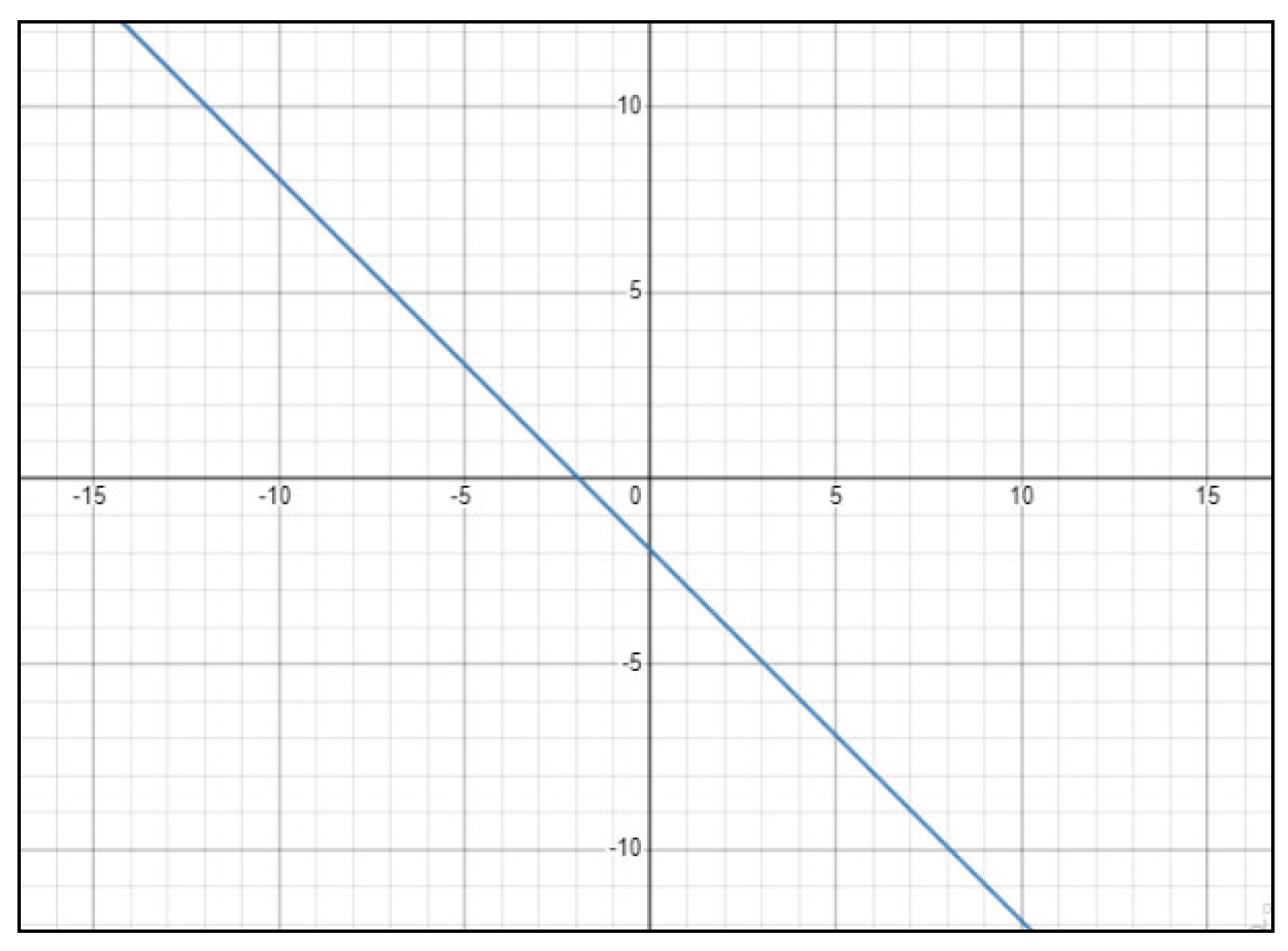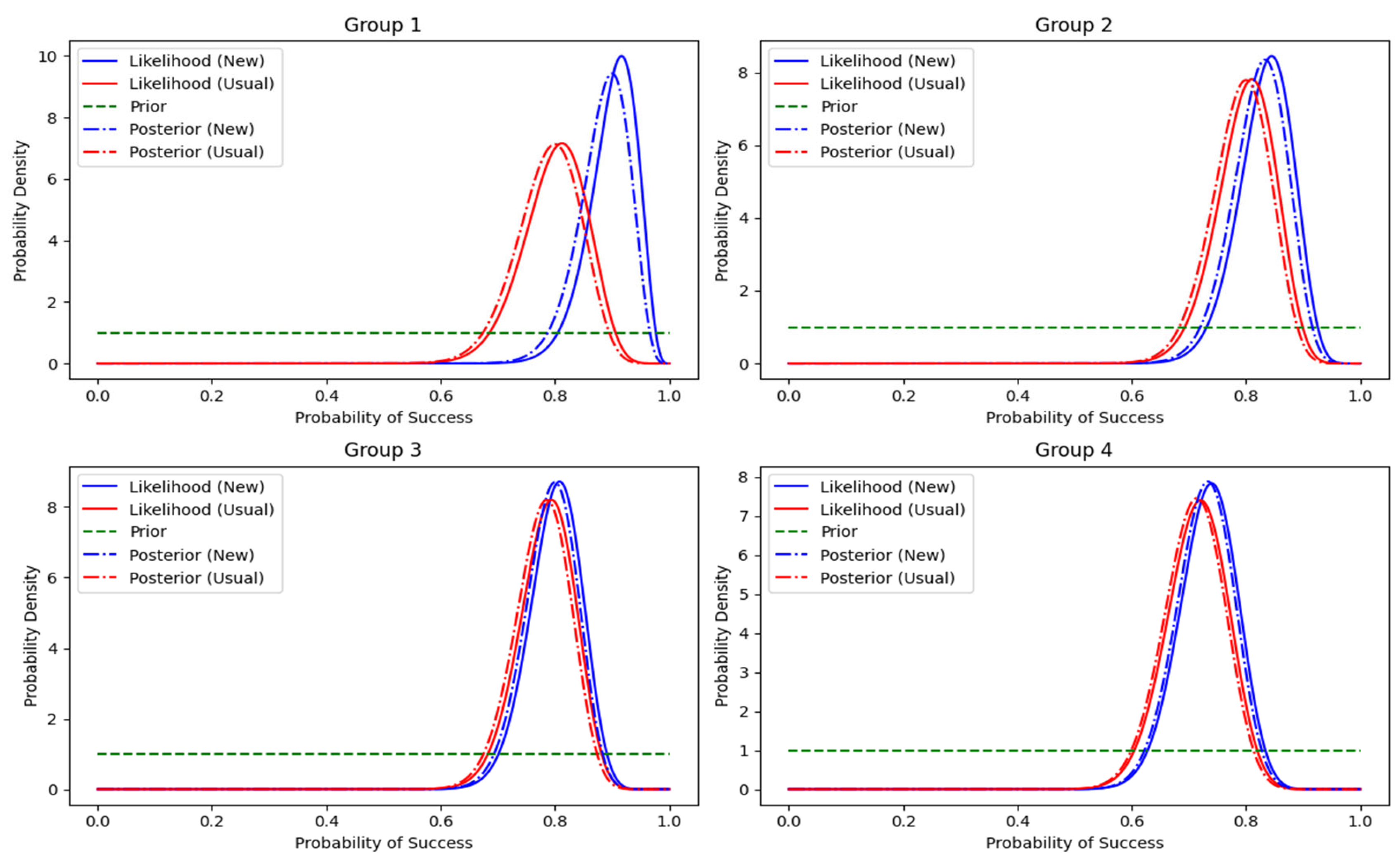Integrating Pedagogical Approaches in the Study of Conic Sections Using Differential Equation and Analysis via Bayesian Inference †
Abstract
:1. Introduction
2. Conic Section and Pedagogical Approach
3. Methodology-1
Illustration 1
4. Methodology-2
- Find ∂/∂x, ∂/∂y;
- Equate both to zero;
- This will give two first-order linear equations;
- These equations can be solved to obtain the required point.
Illustration 2
- (i)
- In view of a pair of straight lines, ax2 + by2 + 2hxy + 2gx + 2fy + c = 0. In the case where in h2-ab is not equal to zero, ∂/∂x = 2ax + 2hy + 2g = 0; ∂/∂y = 2by + 2hx + 2f = 0; Now, we solve x = (bg − hf)/h2 − ab, and y = (af − hg)/h2 − ab. This represents that the two straight lines converges.
- (ii)
- Considering the ellipse, (x − h)2/a2 + (y − k)2 /b2 = 1. Now, ∂/∂x = 2x − 2h = 0 implies x = h; similarly, y = k; This is the center of the ellipse. The result will be the same for the hyperbola.
- (iii)
- Now let us consider a parabola. The general equation is (y − k)2 = 4a(x − h). Now, ∂/∂y = 0, which implies y = k and x = k; this is the vertex of the parabola.
- (iv)
- Consider the Equation 5x2 + 6y2 +6x + 4y + 2 = 0. Now, Ә/Әx = 10x + 6 = 0, which implies x = −3/5; similarly, Ә/Әy = 12y + 4 = 0, which implies y = −1/3. So, the center is (−3/5, −1/3)
- i.
- Hyperbola: if the coefficient of x2 is greater than the coefficient of y2.
- ii.
- Find the eccentricity of the hyperbola by taking the x2 coefficient as b2 and the y2 coefficient as a2, and substituting in the formula b2 = a2 (e2 − 1).
- iii.
- Circle: If the coefficient of x2 is equal to coefficient of y2.
- iv.
- Parabola: If there is only one square term, that is either x2 or y2,and its eccentricity is 1.
- v.
- A pair of straightlines: If there is a xy term in the equation.
5. Bayesian Inference
- (1)
- Specifying a prior distribution entails utilizing a probability distribution to reflect our initial assumptions or level of uncertainty regarding the parameter or model;
- (2)
- Data gathering involves compiling observed data that pertain to the parameter or model;
- (3)
- Defining the likelihood function involves creating a procedure that explains the likelihood of obtaining the observed data given various parameter values.
- (4)
- Applying the Bayes theorem, the posterior distribution can be generated by integrating the likelihood function and prior distribution.
- (5)
- Interpreting the results: based on updated ideas about the parameter, we can draw conclusions, make forecasts, or revise decision making by analysing the posterior distribution.
- (1)
- We indicate the number of students who passed and failed using the new and customary approaches; we define the observed data for the four categories.
- (2)
- In order to illustrate our initial assumption about the success rate, we specify the Beta distribution parameters.
- (3)
- To visualize the distributions, we generate a range of success probabilities (x-axis values).
- (4)
- Considering the observed data and prior knowledge, we use the Beta distribution to generate the posterior parameters for each group.
- (5)
- To display the distributions for the new and conventional approaches, we plot the likelihood, prior, and posterior distributions for each group in distinct subplots.
- (6)
- Figure 4 shows the likelihood, prior, and posterior probabilities for each group so that the two methods may be compared.
6. Result and Conclusions
Author Contributions
Funding
Institutional Review Board Statement
Informed Consent Statement
Data Availability Statement
Conflicts of Interest
References
- Friedman, A.; Reitich, F. Analysis of a mathematical model for the growth of tumors. J. Math. Biol. 1999, 38, 262–284. [Google Scholar] [CrossRef]
- Berthier, N.E. Learning to reach: A mathematical model. Dev. Psychol. 1996, 32, 811. [Google Scholar] [CrossRef]
- Crouch, R.; Haines, C. Mathematical modelling: Transitions between the real world and the mathematical model. Int. J. Math. Educ. Sci. Technol. 2004, 35, 197–206. [Google Scholar] [CrossRef]
- Azzoni, A.; La Barbera, G.; Zaninetti, A. Analysis and prediction of rock falls using a mathematical model. Int. J. Rock Mech. Min. Sci. Geomech. Abstr. 1995, 32, 709–724. [Google Scholar] [CrossRef]
- Pfaffl, M.W. A new mathematical model for relative quantification in real-time RT–PCR. Nucleic Acids Res. 2001, 29, 45. [Google Scholar] [CrossRef] [PubMed]
- Nielsen, J.; Landauer, T.K. A mathematical model of the finding of usability problems. In Proceedings of the INTERACT’93 and CHI’93 Conference on Human Factors in Computing Systems, Amsterdam, The Netherlands, 24–29 April 1993; pp. 206–213. [Google Scholar]
- Brantingham, P.J.; Kuhn, S.L. Constraints on Levallois core technology: A mathematical model. J. Archaeol. Sci. 2001, 28, 747–761. [Google Scholar] [CrossRef]
- Brach, R.M.; Dunn, P.F. A mathematical model of the impact and adhesion of microsphers. Aerosol Sci. Technol. 1992, 16, 51–64. [Google Scholar] [CrossRef]
- Kuo, C.C.J. Understanding convolutional neural networks with a mathematical model. J. Vis. Commun. Image Represent. 2016, 41, 406–413. [Google Scholar] [CrossRef]
- Dutta, D.; Herath, S.; Musiake, K. A mathematical model for flood loss estimation. J. Hydrol. 2003, 277, 24–49. [Google Scholar] [CrossRef]
- Martin, J.C.; Milliken, D.L.; Cobb, J.E.; McFadden, K.L.; Coggan, A.R. Validation of a mathematical model for road cycling power. J. Appl. Biomech. 1998, 14, 276–291. [Google Scholar] [CrossRef]
- Roose, T.; Fowler, A.C.; Darrah, P.R. A mathematical model of plant nutrient uptake. J. Math. Biol. 2001, 42, 347–360. [Google Scholar] [CrossRef] [PubMed]
- Heragu, S.S.; Du, L.; Mantel, R.J.; Schuur, P.C. Mathematical model for warehouse design and product allocation. Int. J. Prod. Res. 2005, 43, 327–338. [Google Scholar] [CrossRef]
- LeGrice, I.J.; Hunter, P.J.; Smaill, B.H. Laminar structure of the heart: A mathematical model. Am. J. Physiol.-Heart Circ. Physiol. 1997, 272, 2466–2476. [Google Scholar] [CrossRef] [PubMed]
- Panetta, J.C.; Adam, J. A mathematical model of cycle-specific chemotherapy. Math. Comput. Model. 1995, 22, 67–82. [Google Scholar] [CrossRef]
- Huang, L. Optimization of a new mathematical model for bacterial growth. Food Control 2013, 32, 283–288. [Google Scholar] [CrossRef]
- Xiong, R.; Xie, G.; Edmondson, A.E.; Sheard, M.A. A mathematical model for bacterial inactivation. Int. J. Food Microbiol. 1999, 46, 45–55. [Google Scholar] [CrossRef]
- Chitnis, N.; Hyman, J.M.; Cushing, J.M. Determining important parameters in the spread of malaria through the sensitivity analysis of a mathematical model. Bull. Math. Biol. 2008, 70, 1272. [Google Scholar] [CrossRef]
- Fussenegger, M.; Bailey, J.E.; Varner, J. A mathematical model of caspase function in apoptosis. Nat. Biotechnol. 2000, 18, 768–774. [Google Scholar] [CrossRef]
- Culshaw, R.V.; Ruan, S. A delay-differential equation model of HIV infection of CD4+ T-cells. Math. Biosci. 2000, 165, 27–39. [Google Scholar] [CrossRef]
- Villasana, M.; Radunskaya, A. A delay differential equation model for tumor growth. J. Math. Biol. 2003, 47, 270–294. [Google Scholar] [CrossRef]
- Spencer, S.L.; Berryman, M.J.; Garcia, J.A.; Abbott, D. An ordinary differential equation model for the multistep transformation to cancer. J. Theor. Biol. 2004, 231, 515–524. [Google Scholar] [CrossRef] [PubMed]
- Garcia, O. A stochastic differential equation model for the height growth of forest stands. Biometrics 1983, 39, 1059–1072. [Google Scholar] [CrossRef]
- Smith, D.; Moore, L. The SIR model for spread of disease—The differential equation model. Convergence Math. Assoc. Am. 2004, 1–4. [Google Scholar]
- Chen, K.C.; Wang, T.Y.; Tseng, H.H.; Huang, C.Y.F.; Kao, C.Y. A stochastic differential equation model for quantifying transcriptional regulatory network in Saccharomyces cerevisiae. Bioinformatics 2005, 21, 2883–2890. [Google Scholar] [CrossRef] [PubMed]
- Gourley, S.A.; Kuang, Y.; Nagy, J.D. Dynamics of a delay differential equation model of hepatitis B virus infection. J. Biol. Dyn. 2008, 2, 140–153. [Google Scholar] [CrossRef] [PubMed]
- Deboeck, P.R.; Bergeman, C.S. The reservoir model: A differential equation model of psychological regulation. Psychol. Methods 2013, 18, 237. [Google Scholar] [CrossRef] [PubMed]
- Chattopadhyay, J.; Sarkar, R.R.; El Abdllaoui, A. A delay differential equation model on harmful algal blooms in the presence of toxic substances. Math. Med. Biol. J. IMA 2002, 19, 137–161. [Google Scholar] [CrossRef]
- Unami, K.; Abagale, F.K.; Yangyuoru, M.; Alam, A.H.M.B.; Kranjac-Berisavljevic, G. A stochastic differential equation model for assessing drought and flood risks. Stoch. Environ. Res. Risk Assess. 2010, 24, 725–733. [Google Scholar] [CrossRef]
- Tamura, Y.; Yamada, S. A flexible stochastic differential equation model in distributed development environment. Eur. J. Oper. Res. 2006, 168, 143–152. [Google Scholar] [CrossRef]
- Myerscough, M.R.; Gray, B.F.; Hogarth, W.L.; Norbury, J. An analysis of an ordinary differential equation model for a two-species predator-prey system with harvesting and stocking. J. Math. Biol. 1992, 30, 389–411. [Google Scholar] [CrossRef]
- Gennemark, P.; Wedelin, D. Efficient algorithms for ordinary differential equation model identification of biological systems. IET Syst. Biol. 2007, 1, 120–129. [Google Scholar] [CrossRef] [PubMed]
- Salahshour, S.; Ahmadian, A.; Senu, N.; Baleanu, D.; Agarwal, P. On analytical solutions of the fractional differential equation with uncertainty: Application to the Basset problem. Entropy 2015, 17, 885–902. [Google Scholar] [CrossRef]
- Shah, K.; Khalil, H.; Khan, R.A. Investigation of positive solution to a coupled system of impulsive boundary value problems for nonlinear fractional order differential equations. Chaos Solitons Fractals 2015, 77, 240–246. [Google Scholar] [CrossRef]
- Semenova, I.N. Methodology of Teaching Mathematics Methods Designing in the Modern Educational Paradigm; Science Book Publishing House LLC: Yelm, WA, USA, 2014; pp. 1–156. [Google Scholar]
- Izquierdo, N.V.; Viloria, A.; Gaitan-Angulo, M.; Bonerg, O.; Lezama, P.; Erase, J.J.C.; Gutierrez, A.S. Methodology of application of diffuse mathematics to performance evaluation. Int. J. Control Theory Appl. 2016, 9, 201–207. [Google Scholar]
- Nortvedt, G.A.; Buchholtz, N. Assessment in mathematics education: Responding to issues regarding methodology, policy, and equity. ZDM—Math. Educ. 2018, 50, 555–570. [Google Scholar] [CrossRef]
- Asiedu-Addo, S.K.; Yidana, I. Mathematics teachers’ knowledge of the subject content and methodology. Math. Connect. 2004, 4, 45–51. [Google Scholar] [CrossRef]




Disclaimer/Publisher’s Note: The statements, opinions and data contained in all publications are solely those of the individual author(s) and contributor(s) and not of MDPI and/or the editor(s). MDPI and/or the editor(s) disclaim responsibility for any injury to people or property resulting from any ideas, methods, instructions or products referred to in the content. |
© 2023 by the authors. Licensee MDPI, Basel, Switzerland. This article is an open access article distributed under the terms and conditions of the Creative Commons Attribution (CC BY) license (https://creativecommons.org/licenses/by/4.0/).
Share and Cite
Delhibabu, R.; Vaithyasubramanian, S.; Sundararajan, R.; Kirubhashankar, C.K.; Vengatakrishnan, K.; P.M.S.S., C. Integrating Pedagogical Approaches in the Study of Conic Sections Using Differential Equation and Analysis via Bayesian Inference. Eng. Proc. 2023, 59, 93. https://doi.org/10.3390/engproc2023059093
Delhibabu R, Vaithyasubramanian S, Sundararajan R, Kirubhashankar CK, Vengatakrishnan K, P.M.S.S. C. Integrating Pedagogical Approaches in the Study of Conic Sections Using Differential Equation and Analysis via Bayesian Inference. Engineering Proceedings. 2023; 59(1):93. https://doi.org/10.3390/engproc2023059093
Chicago/Turabian StyleDelhibabu, R., S. Vaithyasubramanian, R. Sundararajan, C. K. Kirubhashankar, K. Vengatakrishnan, and Chandu P.M.S.S. 2023. "Integrating Pedagogical Approaches in the Study of Conic Sections Using Differential Equation and Analysis via Bayesian Inference" Engineering Proceedings 59, no. 1: 93. https://doi.org/10.3390/engproc2023059093
APA StyleDelhibabu, R., Vaithyasubramanian, S., Sundararajan, R., Kirubhashankar, C. K., Vengatakrishnan, K., & P.M.S.S., C. (2023). Integrating Pedagogical Approaches in the Study of Conic Sections Using Differential Equation and Analysis via Bayesian Inference. Engineering Proceedings, 59(1), 93. https://doi.org/10.3390/engproc2023059093





